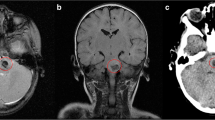Abstract
Case report
A rare case of congenital cavernous angioma detected during pregnancy is described. The tumor was pointed out by ultrasound in a fetus at 39 weeks gestation. The male baby was delivered by cesarean section. Computed tomography and magnetic resonance imaging revealed a tumor in the left basal ganglia. Because the tumor gradually enlarged and right hemiparesis became evident, a decision was made to remove the tumor. Because of profuse intraoperative bleeding, surgical total removal was not accomplished. Histopathological specimens revealed cavernous angioma. The patient was treated postoperatively with 30.4 Gy of local irradiation. His right hemiparesis improved and the tumor gradually decreased in size.
Discussion
The literatures are reviewed and discussed about clinical features and management controversies of this rare tumor.




Similar content being viewed by others
References
Di Rocco C, Iannelli A, Tamburrini G (1996) Cavernomas of the central nervous system in children. Acta Neurochir (Wien) 138:1267–1274
Fortuna A, Ferrante L, Mastronardi L, Acqui M, d’Addetta R(1989) Cerebral cavernous angioma in children. Childs Nerv Syst 5:201–207
Hashimoto H, Sakaki T, Ishida Y, Shimokawara T (1997) Fetal cavernous angioma—case report. Neurol Med Chir (Tokyo) 37:346–349
Jooma R, Kendall BE, Hayward RD (1984) Intracranial tumors in neonates: a report of seventeen cases. Surg Neurol 21:165–170
Jooma R, Hayward RD, Grant DN (1984) Intracranial neoplasms during the first year of life: analysis of one hundred consecutive cases. Neurosurgery 14:31–41
Kano M, Nishiyama K, Mori H, Tanaka R (2003) Multiple large cerebral cavernous angioma in childhood. Pediatr Neurosurg 39:169–170
Kawagishi J, Suzuki M, Kayama T, Yoshimoto T(1993) Huge multilobular cavernous angioma in an infant: case report. Neurosurgery 32:1028–1031
Maruishi M, Shima T, Okada Y, Nishida M, Yamane K, Okita S (1994) Cavernous sinus cavernoma treated with radiation therapy. Neurol Med Chir (Tokyo) 34:773–777
Nakase H, Morimoto T, Tsunoda S, Sakaki T, Yabuno T, Kawai S, Ohnishi H, Hisanaga M, Nikaido Y (1992) Cortical and subcortical cavernous angioma: a comparison of patients with and without hemorrhage as the initial symptom. Neurol Med Chir (Tokyo) 32:196–200
Rigamonti D, Drayer BP, Johnson PC, Hadley MN, Zabramski J, Spetzler RF (1987) The MRI appearance of cavernous malformations (angiomas). J Neurosurg 67:518–524
Rigamonti D, Pappas CTE, Spetzler RF, Johnson P (1990) Extracerebral cavernous angiomas of the middle fossa. Neurosurgery 27:306–310
Robinson JR, Awad IA, Little JR (1991) Natural history of the cavernous angioma. J Neurosurg 75:709–714
Russell DS, Rubinstein LJ (1977) Pathology of tumors of the nervous system. Williams & Wilkins, Baltimore, pp 127–141
Scott RM, Barnes P, Kupsky W, Adelman LS (1992) Cavernous angiomas of the central nervous system in children. J Neurosurg 76:38–46
Shibata S, Mori K (1988) Delayed effect of radiation therapy on extracerebral cavernous angioma in the middle fossa. No Shinkei Geka 16:1005–1008
Steiger HJ, Markwalder TM, Reulen HJ (1987) Clinicopathological relations of cerebral angiomas: observation in eleven cases. Neurosurgery 21:879–884
Suzuki Y, Shibuya M, Baskaya MK, Takakura S, Yamamoto M, Saito K, Glazier SS, Sugita K (1996) Extracerebral cavernous angiomas of the cavernous sinus in the middle fossa. Surg Neurol 45:123–132
Tirakotai W, Fremann S, Soerensen N, Roggendorf W, Siegel AM, Mennel HD, Zhu Y, Bertalanffy H, Sure U (2006) Biological activity of paediatric cerebral cavernomas: an immunohistochemical study of 28 patients. Childs Nerv Syst (Feb 18; in press)
Tomlinson FH, Houser OW, Scheithauer BW, Sundt TM, Okazaki H, Parisi JE (1994) Angiographically occult vascular malformations: a correlative study of features on magnetic resonance imaging and histological examination. Neurosurgery 34:792–800
Zhang N, Pan L, Wang BJ, Dai JZ, Cai PW (2000) Gamma knife radiosurgery for cavernous hemangiomas. J Neurosurg 93(Suppl 3):74–77
Acknowledgements
We would like to express our appreciation to Drs. N Genkai, J Yoshimura, Ms. H Toju, and Ms. H Arai, for their assistance of this work.
Author information
Authors and Affiliations
Corresponding author
Rights and permissions
About this article
Cite this article
Kon, T., Mori, H., Hasegawa, K. et al. Neonatal cavernous angioma located in the basal ganglia with profuse intraoperative bleeding. Childs Nerv Syst 23, 449–453 (2007). https://doi.org/10.1007/s00381-006-0231-3
Received:
Revised:
Published:
Issue Date:
DOI: https://doi.org/10.1007/s00381-006-0231-3




